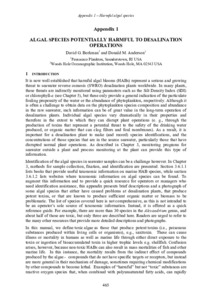| dc.contributor.author | Borkman, David G. | |
| dc.contributor.author | Anderson, Donald M. | |
| dc.date.accessioned | 2019-01-25T14:17:33Z | |
| dc.date.available | 2019-01-25T14:17:33Z | |
| dc.date.issued | 2017 | |
| dc.identifier.citation | Borkman, D.G. and Anderson, D.M. (2017) Appendix 1. Algal species potentially harmful to desalination operations. In: Harmful Algal Blooms (HABs) and Desalination: A Guide to Impacts, Monitoring and Management. (eds. Anderson D. M.; Boerlage, S. F. E. and Dixon, M.B.) Paris, France, Intergovernmental Oceanographic Commission of UNESCO, pp. 456-484. (IOC Manuals and Guides No. 78). DOI: http://dx.doi.org/10.25607/OBP-362 | en_US |
| dc.identifier.uri | http://hdl.handle.net/11329/806 | |
| dc.identifier.uri | http://dx.doi.org/10.25607/OBP-362 | |
| dc.description.abstract | It is now well established that harmful algal blooms (HABs) represent a serious and growing
threat to seawater reverse osmosis (SWRO) desalination plants worldwide. In many plants,
these threats are indirectly monitored using parameters such as the Silt Density Index (SDI)
or chlorophyll-a (see Chapter 5), but these only provide a general indication of the particulate
fouling propensity of the water or the abundance of phytoplankton, respectively. Although it
is often a challenge to obtain data on the phytoplankton species composition and abundance
in the raw seawater, such information can be of great value in the long-term operation of
desalination plants. Individual algal species vary dramatically in their properties and
therefore in the extent to which they can disrupt plant operations (e. g., through the
production of toxins that represent a potential threat to the safety of the drinking water
produced, or organic matter that can clog filters and foul membranes). As a result, it is
important for a desalination plant to make (and record) species identifications, and the
concentrations of those species that are in the source seawater, particularly those that have
disrupted normal plant operations. As described in Chapter 3, monitoring programs for
seawater outside a plant and process monitoring at the plant can provide this type of
information.
Identification of the algal species in seawater samples can be a challenge however. In Chapter
3, methods for sample collection, fixation, and identification are presented. Section 3.6.1.1
lists books that provide useful taxonomic information on marine HAB species, while section
3.6.1.2 lists websites where taxonomic information on algal species can be found. To
augment this information and to provide a quick resource for operators or managers who
need identification assistance, this appendix presents brief descriptions and a photograph of
some algal species that either have caused problems at desalination plants, that produce
potent toxins, or that are known to produce sufficient organic matter or biomass to be
problematic. The list of species covered here is not comprehensive, as this is not intended to
be an operator’s sole source of taxonomic information. Instead, it is offered as a quick
reference guide. For example, there are more than 30 species in the Alexandrium genus, and
about half of those are toxic, but only three are described here. Readers are urged to refer to
the many other resources that provide more detailed descriptions and photographs.
In this manual, we define toxic algae as those that produce potent toxins (i.e., poisonous
substances produced within living cells or organisms), e.g., saxitoxin. These can cause
illness or mortality in humans as well as marine life through either direct exposure to the toxin or ingestion of bioaccumulated toxin in higher trophic levels e.g. shellfish. Confusion
arises, however, because non-toxic HABs can also result in mass mortalities of fish and other
marine life. In this instance, the mortality results from the indirect effect of compounds
produced by the algae - compounds that do not have specific targets or receptors, but instead
are more general in their mechanism of damage, sometimes requiring chemical modifications
by other compounds to become lethal. Examples of “harmful” but not “toxic” substances are
reactive oxygen species that, when combined with polyunsaturated fatty acids, can rapidly kill fish and other animals. Another example is a proteinaceous compound produced by
Akashiwo sanguinea that accumulates on bird feathers, causing a loss in natural water
repellency and widespread mortality of affected animals.
In this appendix, species that do not produce toxins but that do cause marine mortalities are
termed “harmful”. | en_US |
| dc.language.iso | en | en_US |
| dc.publisher | Intergovernmental Oceanographic Commission of UNESCO | en_US |
| dc.relation.ispartofseries | Intergovernmental Oceanographic Commission Manuals and Guides;78 | |
| dc.rights | No Creative Commons license | |
| dc.subject.other | Reverse osmosis | en_US |
| dc.title | Appendix 1. Algal species potentially harmful to desalinitation operations. | en_US |
| dc.type | Report Section | en_US |
| dc.description.status | Published | en_US |
| dc.description.refereed | Refereed | en_US |
| dc.publisher.place | Paris, France | en_US |
| dc.format.pagerange | pp.465-484 | en_US |
| dc.subject.parameterDiscipline | Parameter Discipline::Biological oceanography | en_US |
| dc.description.currentstatus | Current | en_US |
| dc.contributor.editorparent | Anderson, D.M. | |
| dc.contributor.editorparent | Boerlage, S.F.E. | |
| dc.contributor.editorparent | Dixon, M.B. | |
| dc.title.parent | Harmful Algal Blooms (HABs) and Desalination: a Guide to Impacts, Monitoring and Management. | en_US |
| dc.description.bptype | Manual | en_US |
| obps.contact.contactemail | danderson@whoi.edu | |
| obps.resourceurl.publisher | http://hab.ioc-unesco.org/index.php?option=com_oe&task=viewDocumentRecord&docID=22885 | en_US |
 Repository of community practices in Ocean Research, Applications and Data/Information Management
Repository of community practices in Ocean Research, Applications and Data/Information Management
